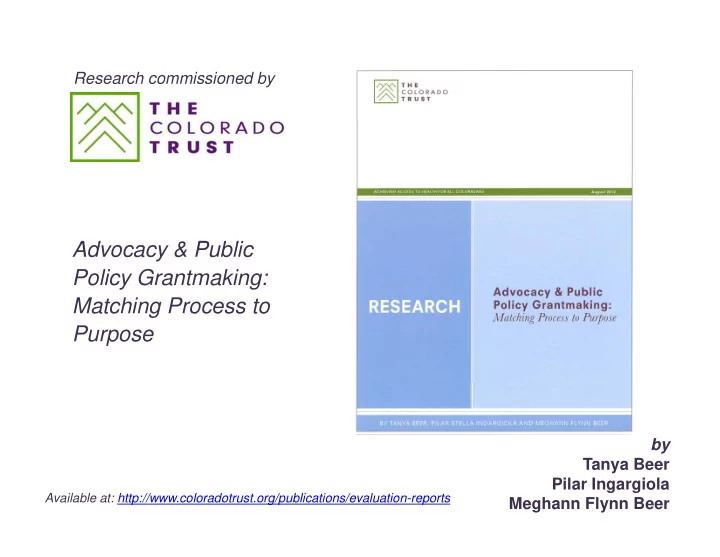

Research commissioned by Ad Advocacy & Public & P bli Policy Grantmaking: Matching Process to Matching Process to Purpose by Tanya Beer Pilar Ingargiola Available at: http://www.coloradotrust.org/publications/evaluation-reports Meghann Flynn Beer
How do your Ad Advocacy grantmaking goals t ki l Affect your Portfolio construction What we What we asked Grant structure P.O. role and relationships Reporting and evaluation Foundation positioning?
Policy Target Approach Three Advocacy Niche Approaches Approach to Advocacy to Advocacy Grantmaking Field Building Approach pp
Policy Target Approach Policy Target Approach Grantmaking and auxiliary activities are designed to Three achieve the passage, successful implementation, and/or maintenance of a specific policy goal. Approaches E Example Goals: l G l Expand children’s health insurance coverage Increase the number of states with freedom to marry for all Ensure health equity with health reform legislation in Oregon Ensure health equity with health reform legislation in Oregon
Ad Advocacy Niche Approach Ni h A h Grantmaking and auxiliary activities support a core element of the infrastructure or perspective within p p an advocacy field. Example Goals: Increase the use of quality data and research by advocates and policymakers working to improve the lives of low-income li k ki t i th li f l i children Increase civic leadership that focuses on improving the health Increase civic leadership that focuses on improving the health of Kansas communities
Field Building Approach Field Building Approach Grantmaking and auxiliary activities are designed to build the stability and long-term adaptive capacity of a field of advocacy and policy organizations that fi ld f d d li i ti th t can shape and respond to a shifting policy environment. environment Example Goals: B ild th Build the capacity of the field of health consumer advocates in it f th fi ld f h lth d t i Missouri Increase the power and capacity of progressive organizations of Increase the power and capacity of progressive organizations of color to engage in effective advocacy
Field Building Approach Di Dimensions of a Field i f Fi ld 1. Field Frame 2. Infrastructure 3 Perspective 3. Perspective 4. Connectivity 5. Adaptive Capacity
Field Building Approach G Grantee Selection t S l ti Consider not just strength of individual Consider not just strength of individual organizations, but how they ‘fit together’ and fill different niches or functions in the field Consider supporting grantees whose role is building connectivity or network weaving Consider how increasing resources for particular organizations changes the power relationships between advocates? Pay attention to field dimensions in relation to y the political context within which advocates work
Field Building Approach PO R l P.O. Role Set a shared vision of the field Political analysis and strategic adaptation Political analysis and strategic adaptation support Fill gaps in infrastructure or perspective Build connectivity Build connectivity Support organically emerging collaborations pp g y g g Facilitate shared field assessments
Field Building Approach O Outcomes Changes in the strength of a “field frame” Changes in the infrastructure of the advocacy field Changes in the infrastructure of the advocacy field Changes in the relative power or “voice” of different perspectives in the field Changes in connectivity and alignment between Changes in connectivity and alignment between actors in the field Changes in adaptive capacity
In the end, the choice of approach is about philosophy and personality … p p y p y what kind of funder you want to be. The composition of your portfolio The composition of your portfolio must have a theory and the P.O.’s role is different in each approach. Funders’ Funders Be cognizant of how your choices Insights affect the power within and shape of p p the overall field. Remember you are within the field Remember you are within the field, not sitting outside it orchestrating change. This means you must have th the adaptive capacity you ask of your d ti it k f grantees.
Recommend
More recommend